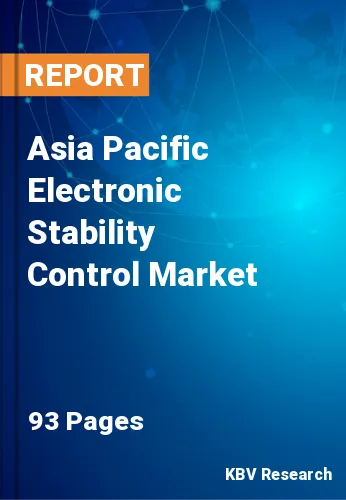The Asia Pacific Electronic Stability Control Market would witness market growth of 8.4% CAGR during the forecast period (2022-2028).
Intermediate-level ESC systems either disable ABS or actively lock the wheels while using the brakes. These systems or vehicles without ABS substantially enhance emergency braking performance in slick circumstances. The gripping state can change quickly and unpredictably off-road when combined with inertia. The tires do not have to deal with the wheel rolling (which provides little braking force) and repeatedly braking when the brakes are applied, and the wheels are locked. The tires' consistent grip allows them to take full advantage of traction wherever it may be found. More aggressive tread designs exacerbate this effect by allowing the vast tread lugs to dig into substrate flaws or surface irregularities and pull debris in front of the tire, further increasing rolling resistance.
To reduce the likelihood of such runaway events happening to inexperienced drivers and to provide a more consistent and safe descent than either no ABS or ABS oriented towards on-road driving, many more modern vehicles are built for off-road use and come equipped with Hill Descent Control systems. These systems are designed to descend at a constant pace (or a speed set by the user), utilizing full locking brakes when necessary and strategic braking or acceleration at the correct times to ensure that all of the wheels rotate at the same rate.
One of the primary economic pillars of India is the automotive sector. It is a significant growth engine with strong backward and forward connections. A dynamic, competitive sector and the introduction of numerous new companies brought about by liberalization and deliberate governmental interventions over the past few years led to an increase in the capacity of the car industry and the creation of significant jobs. This sector's share of the national GDP increased from 2.77% in 1992–1993 to around 7.1% presently. India is quickly becoming a significant automobile center.
The China market dominated the Asia Pacific Electronic Stability Control Market by Country in 2021, and would continue to be a dominant market till 2028; thereby, achieving a market value of $1,433.7 Million by 2028. The Japan market is estimated to grow a CAGR of 7.7% during (2022 - 2028). Additionally, The India market would experience a CAGR of 9% during (2022 - 2028).
Based on Component, the market is segmented into Hydraulic Unit, Sensors and Electronic Control Unit. Based on Vehicle Propulsion, the market is segmented into ICE and Electric & Hybrid. Based on Vehicle Type, the market is segmented into Passenger cars, Light Commercial Vehicles and Heavy Commercial Vehicles. Based on countries, the market is segmented into China, Japan, India, South Korea, Singapore, Malaysia, and Rest of Asia Pacific.
Free Valuable Insights: The Worldwide Electronic Stability Control Market is Projected to reach USD 13.6 Billion by 2028, at a CAGR of 8%
The market research report covers the analysis of key stake holders of the market. Key companies profiled in the report include Robert Bosch GmbH, Continental AG, Johnson Electric Holdings Limited, Aisin Corporation (Toyota Motor Corporation), Valeo SA, Murata Manufacturing Co., Ltd., Hitachi, Ltd., Knorr-Bremse AG, ZF Friedrichshafen AG (TRW), and Mando Corporation (Halla Group).
By Component
By Vehicle Propulsion
By Vehicle Type
By Country
Our team of dedicated experts can provide you with attractive expansion opportunities for your business.

